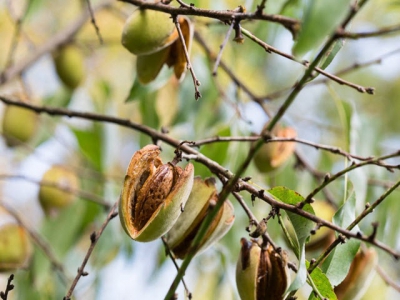Almond industry feed targeted research looks to dairy and beyond

Almond producers in California are exploring the possibility of using almond hulls as feedstock for black solider flies, among other areas.
The almond industry in California has been providing the hulls and shells from almond crops to dairy producers for several years, said Karen Lapsley, chief science officer with the Almond Board of California.
“The California almond industry has provided both hulls and shells to the dairy industry – the hulls as a component of dairy rations and then the shells for bedding or low-value applications of that nature,” she told FeedNavigator. “There is a long history.”
The texture of hull of an almond is similar to the flesh of an apricot, and about 30% of the hull is comprised of sugars, she said.
Although it still plans to work with dairy producers, the group is now expanding its research focus.
“Our industry is in a growth mode from the point of view of California agriculture,” said Lapsley. “It’s the higher value crops that will succeed and both from the point of view of water usage in terms of the best use of available water for California agriculture and the secondly related to labor issues.”
Almond acreage has the potential to expand and there will need to be an outlet for the byproducts generated, she said. “It means there will be more biomass,” she added.
The organization is interested in revisiting some of the original research done regarding the use of almond hulls in cattle diets, and in expanding the research to new areas, she said. “The directive from our industry was let’s revisit the dairy area and let’s better understand if there is any possibility to increase the proportion of almond hulls in dairy rations,” she added.
“The general guidelines have been 10-20%, but based on feed prices and availability in the past decade dairies have been more on the 10% of the fence than the 20% side of the fence – so our industry members asked to sit down with the UC Davis [researchers] and revisit this,” said Lapsley. “That’s how the experiments have been planned, but they haven’t started yet.”
However, the upcoming work with dairy rations are only part of the research work the group is doing, she said.
“The dairy industry, and as a portion of dairy feed, would still be the primary outlet for the almond hulls in the short term,” she said.
Poultry rations, insect rearing feedstock potential
One ongoing project still in its early stages is being done with researchers at the University of Georgia and is examining the potential to feed processed almond hulls in poultry rations, said Lapsley.
Insect farming, right now is a niche area in the US, she said, but is a sector that shows potential.
While work with researchers at the University of California, Davis (UC Davis) on using the almond hulls to raise black soldier fly larvae (BSFL) started a little while ago, and some initial information about the project has been published, she said.
The initial paper, Cultivation of black soldier fly larvae on almond byproducts, was published in in the Journal of the Science of Food and Agriculture, and demonstrates, among other points, that almond hulls can be used as a feedstuff in raising the insects if there also is proper management of moisture and aeration, according to the study.
The BSFL raised would eventually provide a protein source for poultry.
The fly larvae are raised in a closed system using the almond hulls as an energy source, she said. “[Hulls] are about 30% sugars, and this is where the interest lies as an energy source. But, at the same time, they’re also a fiber source, I’m not sure that matters for insects,” she added.
“But in the end where will it go – will there be blending with [other] feed sources?” said Lapsley. “That’s very much still an open research question.”
The ongoing work with BSFL is examining several production elements including the amount of almond hulls that can be used in larvae diets, and how finely ground they need to be, she said.
"We do have [people] looking into investing and having a commercial [insect farming] operation here in California, so, from that point of view, to me that’s promising and that’s exciting,” she added.
The process of raising BSFL on almond hulls also may generate its own co-product, she said.
“The insects like the sugar and they’re able to extract the energy from the almond hulls,” she said. “You’re left with the spent almond hulls after the insects have been harvested and that that stage, this material is quite interesting because it’s still got the fiber backbone to it and it’s porous and from that point of view, it’s got great water holding possibilities.”
A future area for research is set to examine potential roles for that element to be included in soil, and possibly used to grow mushrooms, she said.
Có thể bạn quan tâm
 How to optimise dairy replacement?
How to optimise dairy replacement? It starts with the calves; it always has. But we seem to be lacking in raising those calves to become excellent replacement heifers
 "Farmers often miss the mildly lame cows"
"Farmers often miss the mildly lame cows" When it comes to effectively managing lameness in dairy and beef cattle, there is no magic bullet.
 Chromium use in transition cows
Chromium use in transition cows Trace minerals have critical roles in the immune function and cell metabolism in ruminants. For cows in transition or during early lactation